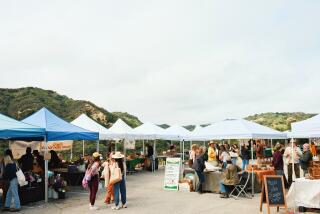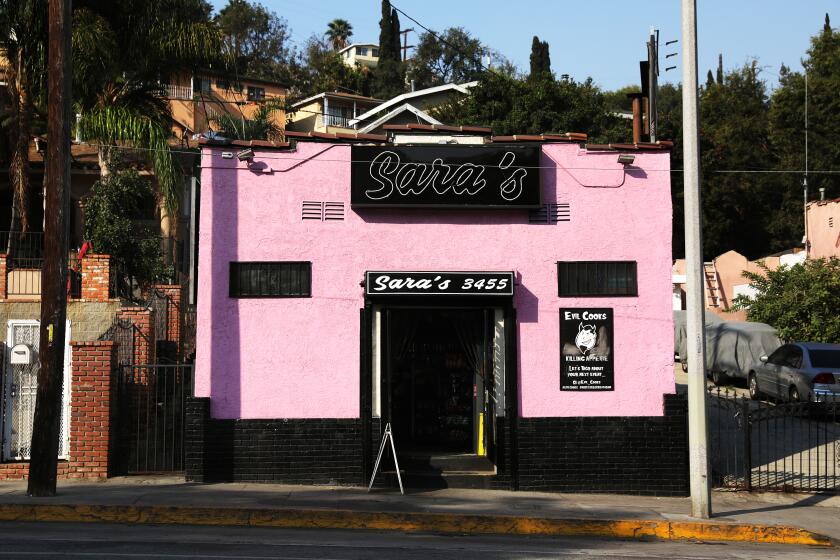Market Watch: In hot pursuit of blueberries, figs and Persian mulberries
Last Wednesday at the Santa Monica market, rivulets of sweat coursed down the brow of Ron Cornelsen, a stone fruit grower from Reedley, and it was only 9 a.m. The previous day it had been 107 degrees in his orchard, and the monsoonal humidity made things so miserable that he had to pay his workers a 30% premium to harvest under such brutal conditions, he said. Even worse, after an unusual late downpour last week, much of his crop dropped from the trees and developed brown rot when it warmed up. When the heat takes such a toll on both humans and produce, it’s time to appreciate those growers, like Cornelsen, who get up at 3 a.m. and drive in from the Fresno area to sell personally at farmers markets.
It’s also the season for shoppers to adapt to the heat by getting to markets early, before the vegetables dry out and the fruit turns soft, to bring a cooler for the most perishable produce, to take into account that many fruits will ripen more quickly and to look especially for those items that flourish in the heat, such as eggplant, zucchini, tomatoes, blackberries and melons. This week, particularly, look out for rabbiteye blueberries and breba figs.
The commercial blueberry harvest in the San Joaquin Valley has finished, but a few enterprising growers have found a way to extend their season by planting rabbiteye blueberries, a species native to the Southeastern United States that can not only take the heat but requires it. Named for the characteristic scar at their bottom ends, rabbiteyes have been cultivated since the late 19th century in northern Florida and southern Georgia and have contributed to the genetic makeup of the Southern highbush blueberry, the main type grown here. Traditionally, however, rabbiteyes were not grown in California and had a dodgy reputation among fruitophiles because the seeds of some varieties can give them a gritty texture; they were seen as a local and acquired taste, like muscadine grapes.
But aside from their unusually late season, July and early August in the San Joaquin Valley, rabbiteyes have a distinctive musky flavor, reminiscent of French violet candies, that makes them worth exploring. Steve Murray, who grows 5 acres of rabbiteyes in Arvin, southeast of Bakersfield, and sells at more than a dozen markets, has two varieties: Powderblue, which is small, very sweet, intensely flavored and relatively grit-free; and Maru, which is larger and tarter. Powderblue is better to my taste for eating fresh, but the sharper Maru, which was bred in New Zealand, might be preferable for baking.
Hot weather during harvest makes conventional blueberries bland but makes rabbiteyes sweeter; in fact, they develop their best flavor only when nights are warm, so they’re perfect for hot areas like Bakersfield. We may be seeing more of them in coming years, now that a glut of regular blueberries has reduced returns to Central Valley growers.
“I make more money from an acre of rabbiteyes than from 15 acres of Southern highbush,” said Murray.
Figs are another fruit that craves heat, particularly the first, early-season breba crop, which typically matures in June in the Central Valley but was late this year because of the cool spring. The breba fruits are larger in size and moister than the second, main crop but can be vegetal and not very sweet or flavorful unless they receive enough heat.
In the past week the brebas have come on like gangbusters, and larger markets like Santa Monica, Torrance and Hollywood each have half a dozen or more fig vendors. This is more than previously, and rightfully so: Figs, which need to be dead ripe to be worth eating, are the textbook example of a fruit that is best purchased at farmers markets and farm stands.
Black Mission figs are the most common and usually the most dependable for good flavor and texture, with tarry skins that contribute a certain spiciness. Mark Boujikian, David Avila, Scott Arnett, Randy Pudwill and Steve Murray have all been bringing good Missions.
The brebas of green-skinned Adriatic figs differ dramatically from the second-crop fruits, which are much smaller, have pulp like strawberry jam and are well suited to drying. The breba Adriatics are much larger and have thicker skins, and yet they’re delicate and quite subject to decay. When it comes to figs, there’s a fine line between fruits that are immature, perfectly ripe and starting to rot, and the trick, particularly with breba Adriatics, is to find fruits that are soft but not overmature. Bob Polito and Mud Creek Ranch both have had good Adriatics recently.
• Tip of the week: The season for Persian mulberries, prized for their intensely sweet-tart, winy flavor, has begun. The sweetest and most flavorful of all, over the years, have been those grown by John Tenerelli in Littlerock and sold at the Hollywood, Santa Monica and Beverly Hills markets. This year much of his stone fruit and cherry crop was wiped out by a late freeze, which didn’t directly affect the mulberries but caused marauding birds to home in on them in the absence of other fodder. Supplies are scarce and erratic, so get to the markets early and put your name on the list for the following market. Other growers, including Weiser, Garcia and the legendary Circle C, should have their mulberries shortly.
More to Read
Eat your way across L.A.
Get our weekly Tasting Notes newsletter for reviews, news and more.
You may occasionally receive promotional content from the Los Angeles Times.








